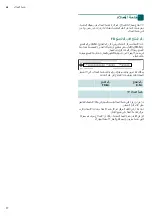
en
Tested for you in our cooking studio
18
J
Tested for you in our
cooking studio
Tested for you in our cooking studio
Note:
A lot of steam can build up in the cooking
compartment when cooking food.
Your appliance is very energy-efficient and radiates very
little heat to its surroundings during operation. Due to
the high difference in temperature between the
appliance interior and the external parts of the
appliance, condensation may build up on the door,
control panel or adjacent kitchen cabinet panels. This is
a normal physical phenomenon. Condensation can be
reduced by preheating the oven or opening the door
carefully.
Tips for using your appliance
Here you will find a selection of tips on ovenware and
preparation methods.
Notes
■
Use the accessories provided. Additional
accessories may be obtained as special accessories
from specialist retailers or from the after-sales
service.
Before using the oven, remove any unnecessary
accessories and ovenware from the cooking
compartment.
■
Always use an oven cloth or oven gloves when
taking accessories or cookware out of the cooking
compartment.
Baking tips
You want to find out whether the cake
is completely cooked in the middle.
Push a cocktail stick into the highest point on the cake. If the cocktail stick comes out clean with no dough res-
idue, the cake is ready.
The cake collapses.
Next time, use less liquid. Alternatively, set the temperature to be 10
°C lower and extend the baking time.
Adhere to the specified ingredients and preparation instructions in the recipe.
The cake has risen in the middle but
is lower around the edge.
Only grease the base of the springform cake tin. After baking, loosen the cake carefully with a knife.
The fruit juice overflows.
Next time, use the universal pan.
Small baked items stick to one
another during baking.
There should be a gap of approx. 2
cm around each item. This gives enough space for the baked items to
expand well and brown on all sides.
The cake is too dry.
Set the temperature 10
°C higher and shorten the baking time.
The cake is generally too light in col-
our.
If the shelf position and the cookware are correct, then you should increase the temperature if necessary or
extend the baking time.
The cake is too light on top, and too
dark underneath.
Bake the cake one level higher in the oven the next time.
The cake is too dark on top, and too
light underneath.
Bake the cake one level lower in the oven the next time. Select a lower temperature and extend the baking
time.
Cakes baked in a tray or tin are too
brown at the back.
Place the baking tray in the middle of the accessories, not directly against the back wall.
The whole cake is too dark.
Select a lower temperature next time and extend the baking time if necessary.
The cake is unevenly browned.
Select a slightly lower temperature.
Protruding greaseproof paper can affect the air circulation. Always cut greaseproof paper to size.
Ensure that the baking tin does not stand directly in front of the openings in the cooking compartment back
wall.
When baking small items, you should use similar sizes and thicknesses wherever possible.
You were baking on several levels.
The items on the top baking tray are
darker than those on the lower baking
tray.
Always select hot air when baking on several levels. Baked items that are placed into the oven on trays or in
baking tins/dishes at the same time will not necessarily be ready at the same time.
The cake looks good, but is not
cooked properly in the middle.
Use a lower temperature and bake slightly longer; if necessary, add slightly less liquid. For cakes with a moist
topping, bake the base first. Sprinkle it with almonds or breadcrumbs and then place the topping on top.
The cake cannot be turned out of the
dish when it is turned upside down.
Allow the cake to cool down for 5
to 10
minutes after baking. If it still sticks, carefully loosen the cake around
the edges again using a knife. Turn the cake tin upside down again and cover it several times with a cold, wet
cloth. Next time, grease the baking tin/dish and sprinkle with breadcrumbs.
















































